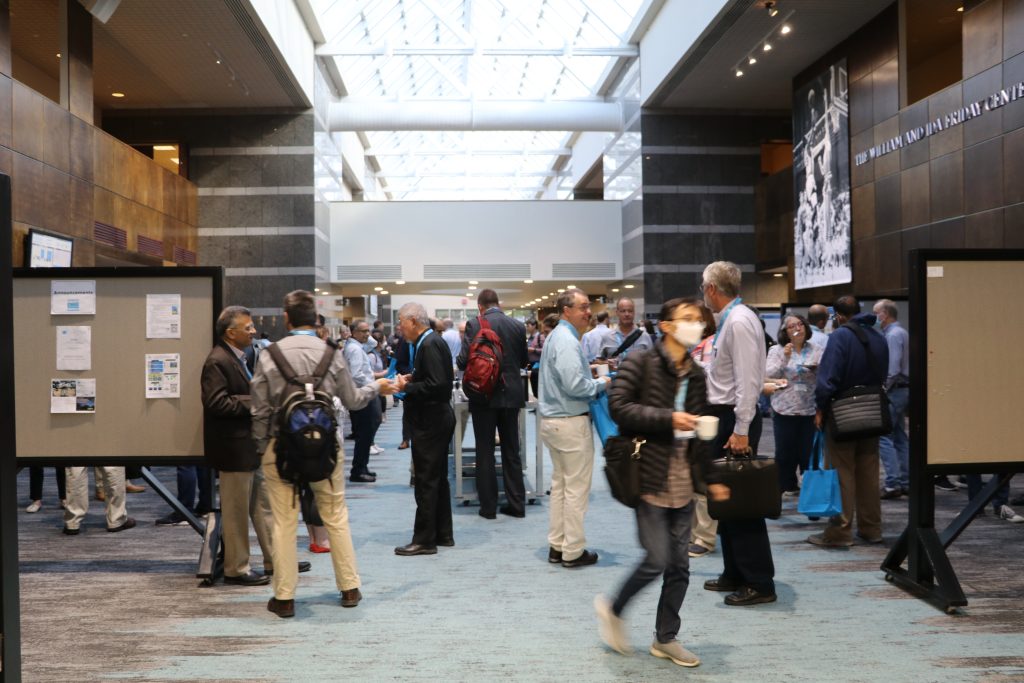‘It is good to be back in person,’ CMAS Center hosts 21st annual conference to tackle complex air quality issues
January 6, 2023
The Community Modeling and Analysis System (CMAS) Center has served the air quality modeling and analysis community for more than two decades by providing access to open-source software that can be used to analyze air quality impacts and develop policies to protect public health. In October, the CMAS Center hosted its 21st annual conference and its first in-person gathering since the COVID-19 pandemic pushed programming to a virtual format. The conference was held at UNC-Chapel Hill’s Friday Center Oct. 17-19.
“The EPA-funded CMAS Center at UNC continues to grow with an ever-increasing need for state-of-the-science models for studying air pollution with innovations in applications that connect air quality with energy, climate and health,” said Sarav Arunachalam, director of the Center for Environmental Modeling for Policy Development and deputy director of the Institute for the Environment. “The presentations this year were a testament to the significant advances the community has collectively made.”
The CMAS Conference attracted approximately 190 attendees from around the world, including experts in the air quality field. A wide breadth of research was presented during the conference, and the conference’s in-person format allowed conversations to thrive.
“A common message I heard from the attendees this year was ‘It is good to be back in person and to catch up with old friends,’” Arunachalam said. “It was rewarding to see both returning members of the CMAS community from previous years, as well as several new students and young scientists, who are starting their careers in air quality modeling, and learn about all the exciting work they are doing.”
Ambassador Barbara J. Stephenson, vice provost for Global Affairs and Chief Global Officer at UNC-Chapel Hill opened the conference with welcoming remarks. Attendees also heard from keynote speakers on agricultural air pollution policy, improved air quality using CMAQ and urban hydrometeorology, climate and environment systems. The three-day event also featured breakout and poster sessions highlighting the latest research and application of air quality models on emerging issues around the world.
In addition to organizing the annual CMAS Conference, the CMAS Center provides modeling education and training to promote development within the community.
More than 10,000 users across the globe benefit from CMAS’s modeling tools. Additionally, community members have access to the CMAS Discourse Forum where they can ask questions about modeling software. Experienced users can respond with advice, cultivating the learning aspect of the modeling community.
Arunachalam shared the center’s efforts to improve available tools and software.
“We are expanding beyond models and tools to distribute large model datasets that users across the world can adapt to their needs and also developing guidance on transitioning to cloud computing,” Arunachalam said.
The center’s Data Warehouse initiative based on the DataVerse project, an open-source repository software application, will make multiple years of emissions, meteorological and air quality datasets, which typically require substantial amounts of storage easily accessible to the CMAS community via the cloud.
“We are at the cusp of this transition, and the CMAS modeling community will likely have a radically different approach to running the various models and tools routinely on the cloud in the next 5-10 years, hopefully much more efficiently than now to address complex air pollution issues,” Arunachalam said.
Currently, three datasets are available to the community: An assortment of various CMAQ inputs and outputs, EPA’s Air QUAlity TimE Series Project (EQUATES) from 2002 to 2019 and one-month conterminous U.S. data from 2016 on the Amazon Web Services (AWS) Open Data Program, which the CMAS Center was provided membership to recently . Transferring these datasets to the cloud will enable users to easily access the data to produce model simulations, create reports and construct interactive visualizations using new technologies directly on the cloud.
The Center’s training programs promote development and education within the modeling community. SMOKE and CMAQ training are the most frequently offered programs, both of which were offered in October. The week-long programs, which are conducted virtually, are typically led by UNC-Chapel Hill staff, and demonstrate how to use modeling software and users take this knowledge to develop their own custom applications.
Training programs have both lecture and hands-on components. Additional training programs and a program schedule are listed on the CMAS website.
In addition to the annual CMAS Conference in Chapel Hill, CMAS organizes conferences in Asia and South America, which provide opportunities for global collaboration.
The CMAS Asia Pacific Conference will be held in Japan in July, and the 5th CMAS South America Conference will be held in Sao Paolo in August. Both programs have not been held recently due to the COVID-19 pandemic.
The 34th International Technical Meeting on Air Pollution Modeling and its Application (ITM) will also be held for the first time in Chapel Hill in May. The CMAS Center will partner with Vito of Belgium and the U.S. EPA to host ITM, which alternates locations between North America and Europe. The meeting has not been hosted in the United States for nearly a decade.
Registration to attend ITM opened on Dec. 15. More information will be available in the following weeks via the CMAS website.
For more information about software releases and future conferences, visit the CMAS website https://cmascenter.org/ or follow CMAS on Twitter @CMAS_Center.
Story by Natalie Peoples
Natalie Peoples is a student at UNC-Chapel Hill. Natalie is currently a sophomore from Kensington, Maryland, pursuing a double major in journalism and environmental science. In addition to her work as a communications intern for the Institute for the Environment, she has experience in photojournalism and environmental research. Natalie plans to pursue a career in environmental journalism with a special interest in marine science.

